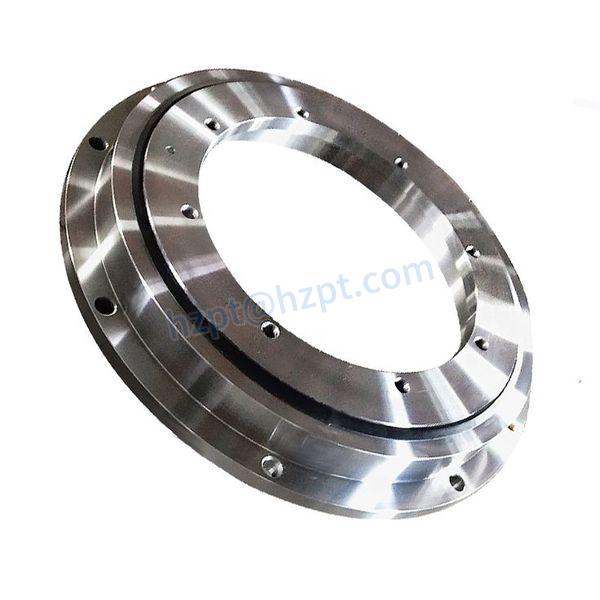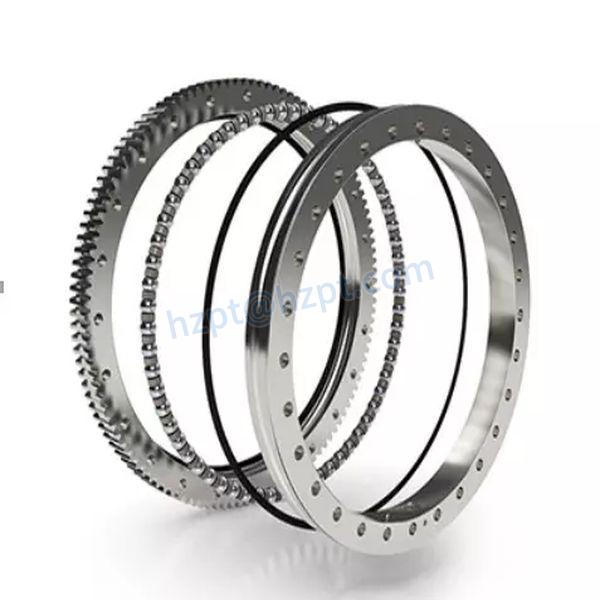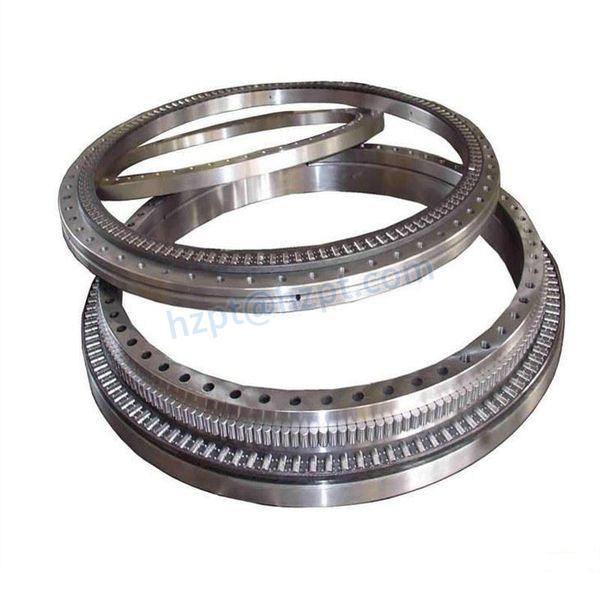Product Description
Welcome to HangZhou XIHU (WEST LAKE) DIS. FLIGHT SEIKO MACHINERY CO.,LTD !
We offer a wide variety of precision machining capabilities including high quality precision machined parts,
Mechanical assemblies,and cutom fabrication for automobile,textile machinery,construction machinery etc.
Our manufacturing and process capabilities are ISO9000 Certified.
Flexible thin section bearing realizes the extremely thin bearing section, and also realizes the miniaturization and lightweight of the products. The variety of products expands its application range. It is generally divided into rubber seal-rs, iron seal-zz, plane, iron card-k, copper card-m.
Characteristic of flexible thin section bearing
|
Designation |
Outer ring |
Inner ring |
Dynamic Load rating |
Static Load rating |
Radial Deformation |
Input rotate speed |
Output |
||
|
Model |
D |
B |
d |
B1 |
Cr |
Cor |
Max.mm |
r/min |
N.m |
|
F14 |
33.896 |
6.095 |
25.07 |
6.35 |
4.74 |
3.75 |
0.2 |
3000 |
8 |
|
F17 |
41.7222 |
6.16 |
30.3 |
6.68 |
7.12 |
5.83 |
0.3 |
3000 |
16 |
|
F20 |
49.073 |
7.24 |
35.56 |
8.13 |
9.93 |
8.36 |
0.3 |
3000 |
30 |
|
F25 |
61.341 |
9.015 |
45.212 |
6.35 |
12.89 |
11.55 |
0.4 |
3000 |
50 |
|
M14 |
33.896 |
6.095 |
25.07 |
6.35 |
5.53 |
4.73 |
0.2 |
3000 |
12 |
|
M17 |
41.722 |
6.16 |
30.3 |
6.68 |
8.31 |
7.35 |
0.3 |
3000 |
24 |
|
M25 |
61.341 |
9.015 |
45.212 |
6.35 |
16.4 |
16.58 |
0.4 |
3000 |
75 |
|
M32 |
79.756 |
11.81 |
58.928 |
8.64 |
27.19 |
28.18 |
0.5 |
3000 |
180 |
Custom size requirement are also available
Our advantage:
1.The original 100% factory, more than 10 years’ production experience
2.Produce and process products according to your drawings and requirement.
3.All kinds of surface treatment available,such as anodizing,power coating,painting,polishing and etc.
4.Our professional R&D and QC team can strictily control the product quality to meet your requirement.
5.Our products are of high quality at cheap price,and delivered on time.
Manufacturing strength & Vehicle processing line
1.Professional operators
2.Adopting advanced CNC machine tools in Japan
3.Totally enclosed production workshop
4.Experienced managers
5.Digital control production line
6.Advanced level of technology
Production Detection
1.Complete testing facilities
2.Perfect measurement methods
3.Perfect production detection methods
4.Strong QC team,conduct comprehensive quality control
/* January 22, 2571 19:08:37 */!function(){function s(e,r){var a,o={};try{e&&e.split(“,”).forEach(function(e,t){e&&(a=e.match(/(.*?):(.*)$/))&&1
| Standard or Nonstandard: | Customized |
|---|---|
| Sealing Gland: | Customized |
| Rolling-Element Number: | Customized |
| Roller Type: | Customized |
| Material: | Customized |
| Type: | Customized |
| Samples: |
US$ 0/Piece
1 Piece(Min.Order) | |
|---|
| Customization: |
Available
| Customized Request |
|---|

How do Slewing Bearings Contribute to the Smooth Rotation of Cranes and other Heavy Machinery?
Slewing bearings play a vital role in ensuring the smooth and efficient rotation of cranes and other heavy machinery that require controlled movement. Their design and functionality are specifically tailored to handle the unique challenges posed by such applications. Here’s how slewing bearings contribute to the smooth rotation of cranes and heavy machinery:
- Load Handling:
Crane operations involve lifting and moving heavy loads. Slewing bearings are designed to carry substantial axial, radial, and moment loads simultaneously. This load-handling capacity allows cranes to lift and transport heavy objects with precision.
- Smooth Rotation:
Slewing bearings provide a smooth interface between the upper structure (superstructure) and the lower structure (substructure) of the machinery. This allows for controlled and precise rotation of the upper structure, enabling cranes to maneuver smoothly during lifting, loading, and unloading operations.
- Efficient Torque Transmission:
During crane rotation, torque generated by the motor is transmitted through the slewing bearing to the upper structure. The bearing’s design ensures efficient torque transmission, minimizing energy losses and facilitating smooth rotation even under heavy loads.
- Low Friction and Wear:
Slewing bearings are engineered to minimize friction and wear. This reduces the energy required for rotation and prevents premature wear that could affect the bearing’s performance and longevity.
- High Stiffness:
Slewing bearings exhibit high stiffness, which contributes to the stability of the machinery during rotation. This stiffness ensures minimal deflection and maintains precise alignment, essential for safe and controlled movement.
- Uniform Load Distribution:
The raceway design of slewing bearings promotes uniform load distribution among rolling elements. This prevents stress concentrations and uneven wear, enhancing the bearing’s durability and contributing to smooth operation.
- Slow and Controlled Movement:
Crane operations often require slow and controlled rotation, especially when positioning heavy loads. Slewing bearings facilitate this type of movement, allowing operators to make precise adjustments.
- Customization for Specific Applications:
Slewing bearings can be customized to match the specific requirements of different crane designs and applications. This customization ensures optimal performance and longevity in various operational scenarios.
In summary, slewing bearings are essential components that enable the smooth and precise rotation of cranes and heavy machinery. Their load-carrying capacity, low friction, high stiffness, and ability to transmit torque efficiently contribute to the reliable and controlled movement required for various lifting and loading operations.

What are the Signs of a Damaged or Worn-out Slewing Bearing that Requires Replacement?
Identifying the signs of a damaged or worn-out slewing bearing is essential for preventing potential failures and ensuring equipment reliability. Here are common indicators that a slewing bearing may require replacement:
- Unusual Noise:
If you notice grinding, clicking, or any abnormal noises during operation, it could be a sign of wear or misalignment in the slewing bearing.
- Increased Vibration:
Excessive vibration or shaking during rotation could indicate misalignment, damage, or uneven wear in the slewing bearing.
- Irregular Movement:
If the machinery exhibits irregular or jerky movement instead of smooth rotation, it might be due to a damaged slewing bearing.
- Uneven Load Distribution:
Uneven distribution of loads can lead to accelerated wear on specific sections of the bearing, causing premature failure.
- Abnormal Heat Generation:
If the slewing bearing becomes excessively hot during operation, it may suggest friction, misalignment, or lack of proper lubrication.
- Excessive Play or Clearance:
Too much axial or radial play in the bearing can indicate wear, misalignment, or component fatigue, requiring inspection and potential replacement.
- Leakage of Lubricant:
If lubricant leaks from the bearing or seals, it may signify damage to the sealing mechanism or an internal issue that needs attention.
- Visible Wear or Damage:
Inspect the bearing for visible signs of wear, corrosion, pitting, or other forms of damage. Cracks, dents, or deformation are clear indicators of potential problems.
- Reduced Performance:
If the machinery’s performance deteriorates, such as decreased rotation speed, reduced load capacity, or increased power consumption, it could be due to a failing slewing bearing.
- Increased Maintenance Frequency:
If you find yourself needing to perform more frequent maintenance or repairs on the bearing, it might indicate that the bearing is nearing the end of its service life.
- Manufacturer’s Service Life:
Consult the manufacturer’s guidelines for the expected service life of the slewing bearing. If the bearing is approaching this limit, it’s advisable to consider replacement.
If any of these signs are observed, it’s important to consult with experts and consider replacing the slewing bearing to prevent further damage and ensure the safe and efficient operation of machinery.

What Factors Should Be Considered When Selecting a Slewing Bearing for a Specific Application?
Selecting the right slewing bearing for a specific application requires careful consideration of various factors to ensure optimal performance and longevity. Some crucial factors to take into account include:
- Load Requirements: Determine the axial, radial, and moment loads that the slewing bearing will need to support. Choose a bearing with an appropriate load-carrying capacity for the application.
- Space Limitations: Consider the available installation space, both in terms of diameter and height. Choose a slewing bearing that fits within the allocated space without compromising functionality.
- Rotational Speed: Determine the required rotational speed of the bearing. Higher rotational speeds may require bearings with advanced designs and materials to manage heat and wear.
- Environmental Conditions: Assess the operating environment for factors like temperature, humidity, dust, and corrosive substances. Select a bearing with suitable seals and coatings to withstand these conditions.
- Accuracy and Precision: For applications requiring precise positioning, such as robotics or industrial machinery, choose a bearing that offers the necessary level of accuracy in rotation.
- Mounting and Assembly: Consider the ease of installation and any special mounting requirements. Some bearings come with integrated mounting features, simplifying the assembly process.
- Lubrication and Maintenance: Evaluate the lubrication needs of the bearing. Some bearings require periodic maintenance, while others are designed for long-term lubrication.
- Expected Lifespan: Determine the desired lifespan of the bearing in relation to the application’s operational requirements. High-quality bearings with robust construction may offer longer service life.
- Cost-Benefit Analysis: Balance the initial investment with long-term benefits. Consider factors like maintenance costs, downtime, and overall equipment performance.
- Industry Standards: Ensure that the selected slewing bearing complies with relevant industry standards and regulations for safety and quality.
Ultimately, the selection process involves matching the unique requirements of the application with the capabilities of the slewing bearing. Consulting with bearing manufacturers and experts can provide valuable insights to make an informed decision.


editor by CX 2024-05-08
by
Tags:
Leave a Reply